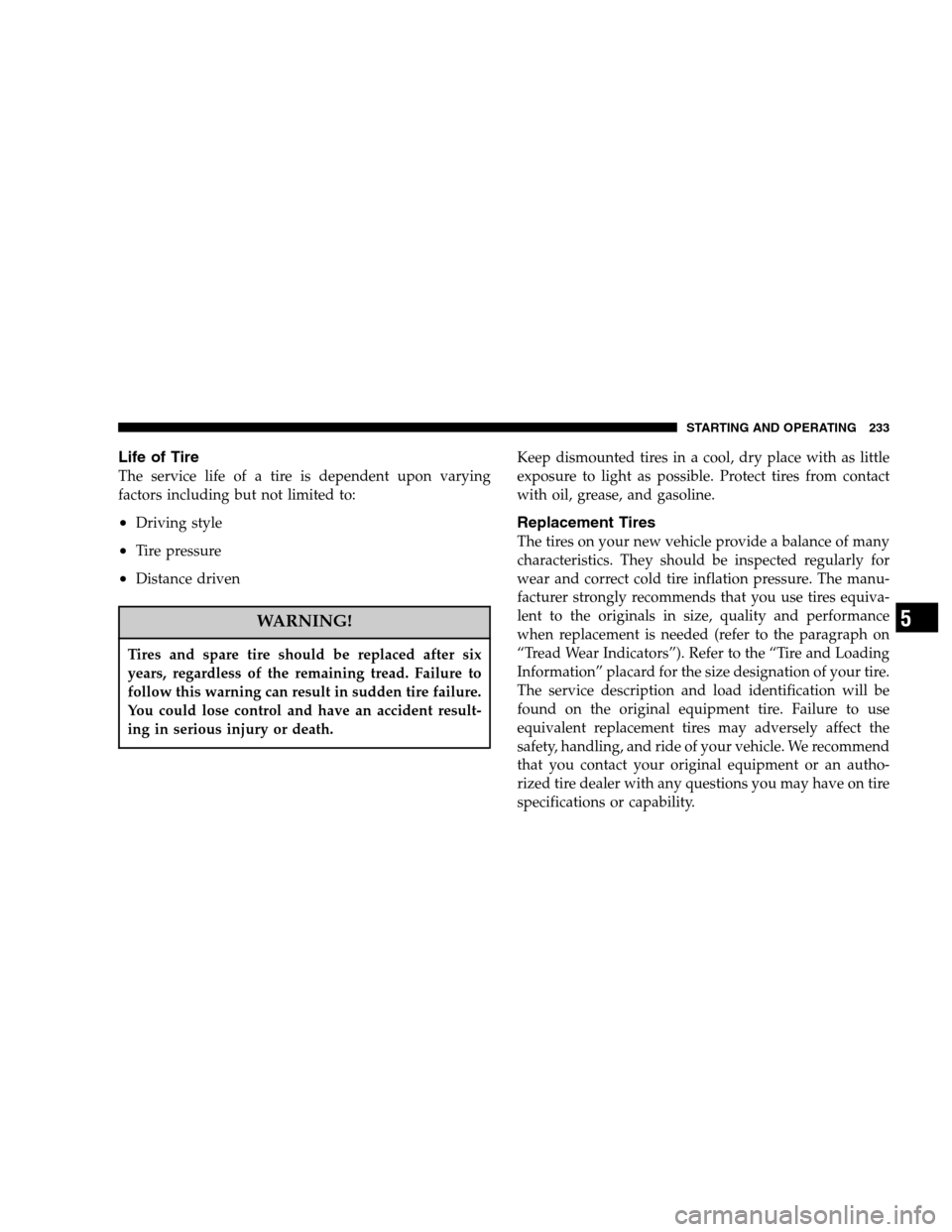2007 DODGE DAKOTA inflation pressure
[x] Cancel search: inflation pressurePage 231 of 400

Limited Use Spare — If Equipped
The limited use spare tire is for temporary emergency use
on your vehicle. This tire is identified by a limited use
spare tire warning label located on the limited use spare
tire and wheel assembly. This tire may look like the
original equipped tire on the front or rear axle of your
vehicle, but it is not. Installation of this limited use spare
tire affects vehicle handling. Since it is not the same tire,
replace (or repair) the original tire and reinstall on the
vehicle at the first opportunity.WARNING!
The limited use spare tires are for emergency use
only. Installation of this limited use spare tire affects
vehicle handling. With this tire, do not drive more
than 60 mph (100 km/h). Keep inflated to the cold
tire inflation pressure listed on either your tire
placard or limited use spare tire and wheel assembly.
Replace (or repair) the original tire at the first
opportunity and reinstall it on your vehicle. Failure
to do so could result in loss of vehicle control.
Tire Spinning
When stuck in mud, sand, snow, or ice conditions, do not
spin your vehicle’s wheels above 35 mph (55 km/h).
Refer to the paragraph on “Freeing A Stuck Vehicle” in
Section 6 of this manual.
STARTING AND OPERATING 231
5
Page 233 of 400

Life of Tire
The service life of a tire is dependent upon varying
factors including but not limited to:
•Driving style
•Tire pressure
•Distance driven
WARNING!
Tires and spare tire should be replaced after six
years, regardless of the remaining tread. Failure to
follow this warning can result in sudden tire failure.
You could lose control and have an accident result-
ing in serious injury or death.
Keep dismounted tires in a cool, dry place with as little
exposure to light as possible. Protect tires from contact
with oil, grease, and gasoline.
Replacement Tires
The tires on your new vehicle provide a balance of many
characteristics. They should be inspected regularly for
wear and correct cold tire inflation pressure. The manu-
facturer strongly recommends that you use tires equiva-
lent to the originals in size, quality and performance
when replacement is needed (refer to the paragraph on
“Tread Wear Indicators”). Refer to the “Tire and Loading
Information” placard for the size designation of your tire.
The service description and load identification will be
found on the original equipment tire. Failure to use
equivalent replacement tires may adversely affect the
safety, handling, and ride of your vehicle. We recommend
that you contact your original equipment or an autho-
rized tire dealer with any questions you may have on tire
specifications or capability.
STARTING AND OPERATING 233
5
Page 235 of 400

Improper alignment will not cause vehicle vibration.
Vibration may be a result of tire and wheel out-of-
balance. Proper balancing will reduce vibration and
avoid tire cupping and spotty wear.
SUPPLEMENTAL TIRE PRESSURE INFORMATION
– IF EQUIPPED
A light load vehicle condition is defined as two passen-
gers {150 lbs (68 kg) each} plus 200 lbs (91kg) of cargo.
Cold tire inflation pressures for a lightly loaded vehicle
will be found on the face of the driver’s door.
TIRE CHAINS
CAUTION!
•The use of chains is permitted only on vehicles
equipped with P245/70R16 tires.
•Use only “Class S” chains or other traction aids
that meet SAE Type “S” specifications.
•Tire chain use is permitted only on the rear tires.
•Chains must be the proper size for the vehicle, as
recommended by the chain manufacturer.
STARTING AND OPERATING 235
5
Page 237 of 400

CAUTION!
•Do not use tire chains on vehicles equipped with
tires other than P245/70R16. There may not be
adequate clearance for the chains and you are
risking structural or body damage to your vehicle.
•Do not use tire chains on the front wheels of your
vehicle. There may not be adequate clearance for
the chains and you are risking structural or body
damage to your vehicle.
SNOW TIRES
Snow tires should be of the same size and type construc-
tion as the front tires. Consult the manufacturer of the
snow tire to determine any maximum vehicle speed
requirement associated with the tire. These tires should
always be operated at the vehicle maximum capacity
inflation pressures under any load condition.While studded tires improve performance on ice, skid
and traction capability on wet or dry surfaces may be
poorer than that of non-studded tires. Some states pro-
hibit studded tires; therefore, local laws should be
checked before using these tire types.
TIRE ROTATION RECOMMENDATIONS
Tires on the front and rear axles of vehicles operate at
different loads and perform different steering, driving,
and braking functions. For these reasons, they wear at
unequal rates and tend to develop irregular wear pat-
terns. These effects can be reduced by timely rotation of
tires. The benefits of rotation are especially worthwhile
with aggressive tread designs such as those on all season
type tires. Rotation will increase tread life, help to main-
tain mud, snow and wet traction levels, and contribute to
a smooth, quiet ride.
STARTING AND OPERATING 237
5
Page 249 of 400

Each axle GAWR is determined by the component in the
system with the lowest load carrying capacity (axle,
springs, tires, or wheels).
Heavier axles or suspension components sometimes
specified by purchasers for increased durability do not
necessarily increase the vehicle’s GVWR.
Tire Size
This is the minimum allowable tire size for your vehicle.
Replacement tires must be equal to the load capacity of
this tire size.
Rim Size
This is the rim size that is appropriate for the tire size
listed.
Inflation Pressure (Cold)
This is the cold tire inflation pressure for your vehicle for
all loading conditions up to full GAWR.
Curb Weight
The curb weight of a vehicle is defined as the total weight
of the vehicle with all fluids, including vehicle fuel, at full
capacity conditions, and with no occupants or cargo
loaded into the vehicle. The front and rear curb weight
values are determined by weighing your vehicle on a
commercial scale before any occupants or cargo are
added.
Loading
The actual total weight and the weight of the front and
rear of your vehicle at the ground can best be determined
by weighing it when it is loaded and ready for operation.
The entire vehicle should first be weighed on a commer-
cial scale to insure that the GVWR has not been exceeded.
The weight on the front and rear of the vehicle should
then be determined separately to be sure that the load is
properly distributed over front and rear axle. Weighing
the vehicle may show that the GAWR of either the front
STARTING AND OPERATING 249
5
Page 260 of 400

2. GTW
3. GAWR
4. Tongue weight rating for the trailer hitch utilized
(This requirement may limit the ability to always
achieve the 10% to 15% range of tongue weight as a
percentage of total trailer weight).
Towing Requirements — Tires
�
Do not attempt to tow a trailer while using a compact
spare tire.
�Proper tire inflation pressures are essential to the safe
and satisfactory operation of your vehicle. Refer to the
Tires–General Information section of this manual on
Tire Pressures for proper tire inflation procedures.
�Also, check the trailer tires for proper tire inflation
pressures before trailer usage.
�Check for signs of tire wear or visible tire damage
before towing a trailer. Refer to the Tires–General
Information section of this manual on Tread Wear
Indicators for the proper inspection procedure.
�When replacing tires refer to the Tires–General Infor-
mation section of this manual on Replacement Tires for
proper tire replacement procedures. Replacing tires
with a higher load carrying capacity will not increase
the vehicle’s GVWR and GAWR limits.
Towing Requirements — Trailer Brakes
�
Donotinterconnect the hydraulic brake system or
vacuum system of your vehicle with that of the trailer.
This could cause inadequate braking and possible
personal injury.
�An electronically actuated trailer brake controller is
required when towing a trailer with electronically
260 STARTING AND OPERATING
Page 385 of 400

Inflation Pressure Tires.................... 235
Inside Rearview Mirror.................... 79
Instrument Cluster....................... 136
Instrument Panel and Controls.............. 134
Instrument Panel Lens Cleaning............. 326
Interior Appearance Care.................. 325
Interior Lights........................... 90
Intermittent Wipers (Delay Wipers)............ 97
Introduction............................. 4
Jack Operation.......................273,278
Jacking Instructions...................... 279
Key, Replacement........................ 16
Key, Sentry (Immobilizer)................... 15
Keyless Entry System...................... 20
Keys................................. 12
Knee Bolster............................ 44Lane Change and Turn Signals......... 94,136,338
Lap/Shoulder Belts....................... 35
LATCH (Lower Anchors and Tether for CHildren) . 61
LifeofTires ............................ 233
Lights ............................... 74,90
Airbag............................ 54,142
Anti-Lock Warning..................... 139
Back-Up............................. 338
Brake Warning........................ 141
Bulb Replacement...................332,333
Cargo ............................... 94
Center Mounted Stop................... 341
Courtesy/Reading..................... 103
Cruise .............................. 143
Daytime Running....................... 93
Fog ........................... 93,137,345
Hazard Warning Flasher................. 272
Headlights............................ 92
High Beam........................... 96
INDEX 385
10
Page 392 of 400

Chains.............................. 235
Changing............................ 273
Compact Spare........................ 230
General Information.................... 226
High Speed.......................... 229
Inflation Pressures..................... 227
Jacking............................. 278
LifeofTires .......................... 233
Load Capacity.....................222,223
Quality Grading....................... 375
Radial.............................. 229
Replacement......................... 233
Rotation............................. 237
Safety...........................218,226
Sizes ............................... 219
Snow Tires........................... 237
Spare Tire........................... 275
Spinning ............................ 231
Tread Wear Indicators................... 232Wheel Mounting....................... 278
Wheel Nut Torque..................... 281
Tongue Weight/Trailer Weight.............. 257
Torque Converter Clutch.................. 195
Tow Hooks, Emergency................... 285
Towing ............................... 251
Disabled Vehicle....................... 286
Guide .............................. 257
Recreational.......................... 265
Weight .............................. 257
Traction ............................... 211
TrailerTowing .......................... 251
Cooling System Tips.................... 264
Hitches............................. 256
Minimum Requirements................. 258
Trailer and Tongue Weight................ 257
Wiring .............................. 261
TrailerTowingGuide ..................... 257
TrailerWeight .......................... 257
392 INDEX